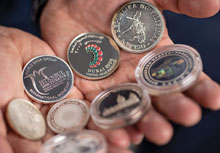Currency Notes
Special Occasion Coins
Commemorative material highlights an annual global gathering
COMMEMORATIVE COINS to mark special occasions or events have been around for centuries. In ancient Rome, commemorative coins were minted to celebrate victorious military campaigns. Today, such coins are issued to celebrate international cooperation and cultural diversity.
Since the creation of the International Monetary Fund and the World Bank Group in 1944, the leadership and member countries of both institutions have met every autumn to address critical issues facing the global economy. For the inaugural meeting of the governing body, held in the US city of Savannah, Georgia, in March 1946, a special brass medal was designed depicting US President Franklin Delano Roosevelt on one side and the outline of the state of Georgia on the other. The commemorative medal was placed at each delegate’s dinner plate.
These Annual Meetings usually take place in Washington, DC, but every third year leaders congregate abroad in one of the institutions’ 189 member countries. To commemorate and promote the global gathering, host countries take advantage of the limelight by issuing coins, stamps, currency notes, special medals, and other memorabilia, often drawing attention to their local culture, economic progress, and technological innovation.
Coins and banknotes are particularly fitting given that the focus of the convening institutions includes safeguarding the global financial system. In most cases, commemorative coins can’t be used to go shopping, but they do hold special value and are sought after by collectors. For example, a 1,500 piso gold coin—the first tribute of its kind—issued by the Philippines when it hosted the 1976 Annual Meetings can fetch more than $1,500 at auction. Its current face value is $28. Thailand, Spain, the Czech Republic, the United Arab Emirates, Singapore, Turkey, and Japan all followed suit by issuing their own unique coins.
Thailand went a step further in 1991, issuing a special commemorative folder containing banknotes of 10, 20, 50, 100, and 500 baht that were overprinted with “1991 World Bank Group/IMF Annual Meetings” in both Thai and English at the bottom and “Specimen” diagonally across each note.
Symbolically, each set of commemorative coins represents the progress and wonder of the host nation and is produced using the latest minting technology. In Dubai in 2003, the United Arab Emirates became the first country to use color in an Annual Meetings coin design. In 2006, when Singapore played host, coins were issued featuring a bustling skyline and a map of the world, conveying the country’s position as an international financial hub. In 2012, Japan used special iridescent technology and microfabrication to give a rainbow-like shine to its commemorative coin depicting Mt. Fuji.
In 2015, Peru designed a beautiful silver medal instead of a coin, because Peruvian law requires one face of all coins, including commemorative coins, to display the national coat of arms— limiting a historic design to one side only. Choosing the medal format allowed for more space to depict the Cathedral of Lima, centerpiece of a UNESCO World Heritage Site, on one side and the new Annual Meetings donut-shaped logo of flags on the other.
This year, the Annual Meetings are being held in Bali, and the host country of Indonesia will issue commemorative stamps. If you are attending the meetings, you may want to get your hands on more than one: they could become quite valuable someday.
Opinions expressed in articles and other materials are those of the authors; they do not necessarily reflect IMF policy.









